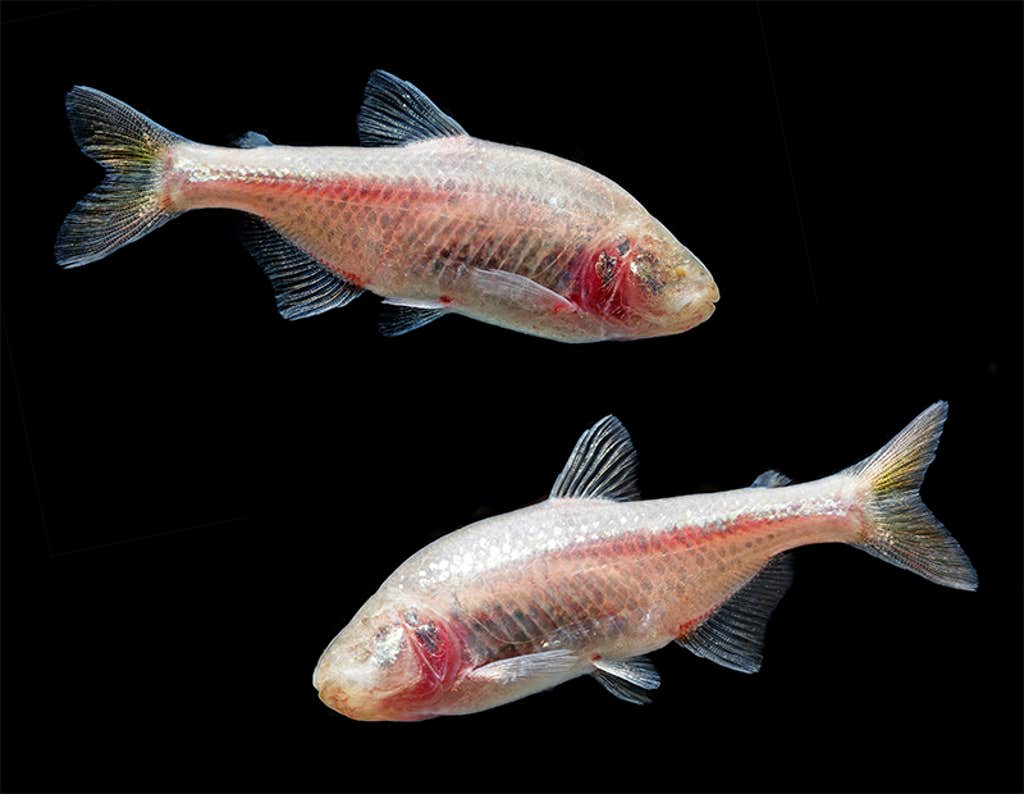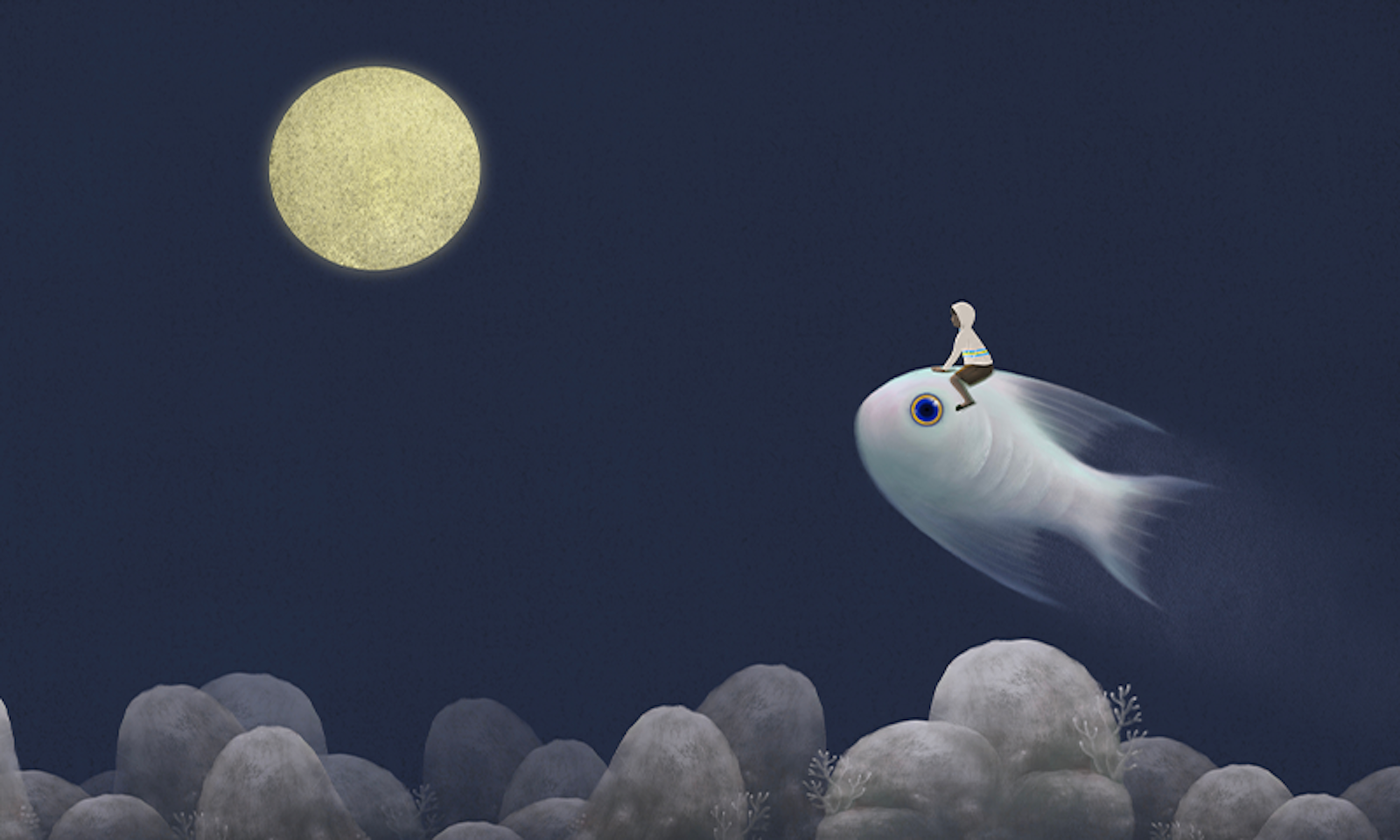On the surface, sleep seems obvious, essential. It comes in long, languid, predictable waves, washing over humans and elephants, birds and fish and beetles. It comes bearing restoration, repair, learning. It follows an ancestral rhythm played deep within our cells, cued by the movement of our planet around our star.
Perhaps we could believe this nice, simple fantasy, were it not for an irksome little eyeless fish.
More than a decade ago, this fish—the Mexican tetra (Astyanax mexicanus)—caught the eye of a graduate student at New York University. It was not new to science—it had been the subject of fascination for aquarists and researchers for decades, who marveled at its ghostly appearance and the splash of skin where its eyes should have been. But other quirks of the fish turned out to be even more mysterious.
In Manhattan, the fish were far from their place of origin: a collection of unassuming caves strung through northeastern Mexico. Inside these caves, it is pitch dark, always cool, quiet, and rather boring. A seemingly perfect place to sleep.
Sleep is a terribly disadvantageous state to be in.
So Erik Duboué, the curious graduate student, decided to test if these fish showed any unusual sleep habits. One night in 2009, he made a 2 a.m. visit to the lab and noticed something strange about these sightless fish: They seemed wide awake. On further investigation, he found that despite their soporific native environs, they actually hardly sleep at all. In fact, he discovered, they doze just about three and a half hours out of each 24-hour period. And their bouts of sleep seem to come on entirely randomly and only in brief spurts.
Curiously, these eyeless cavefish seem to have been flourishing on this quiescence interruptus for hundreds of thousands of years. “What you have is a fish that is completely healthy—it just doesn’t need to sleep,” says Duboué, who is now a molecular geneticist at Florida Atlantic University.
Since then, Duboué and others have been studying the strange sleep of these wakeful creatures—prodding them in the lab to rouse them from their occasional slumber and plumbing their DNA. Combined with investigations into other animals, as well as some peculiar experiments that have sent humans to sleep in caves, scientists are uncovering new, closely guarded truths about sleep that have eluded us in our bright, rhythmic world.
In the panoply of evolution’s creations, plenty of animals actually appear to do just fine on little sleep. Frigatebirds in the Galapagos go on weeks- (and sometimes months-) long hunting trips over the ocean, drifting off to sleep—mid-flight—for only a few minutes at a time and fewer than 40 minutes total each night—less than a tenth of their usual nightly rest. Even the sagacious African elephant seems to sleep only a couple fragmented hours a night in the wild—while living into their 60s and 70s and maintaining astonishing cognitive, social, linguistic, and recollective capabilities. These and other extreme examples have thrown into question our long-held assumptions about the primacy of sleep.
But the Mexican blind cavefish piqued Duboué’s interest because their sleeplessness was particularly unexpected. Members of the very same species, A. mexicanus also live and thrive just outside the caves—darting through glinting, sunlit rivers. These fishes are decorated to match their environment, have two perfectly functional eyes, and catch a healthy 13 hours of Zs.
The differences between the populations—surface- and cave-dwelling—had made the fishes a quiet darling of biologists: They offered a real-life way to probe the work of evolution. But scientists had largely focused on the fishes’ striking physical differences. These adaptations made some sense. No need to throw energy into growing eyes or creating pigments if they were perfectly useless in the pitch dark.
Until Duboué came along, though, no one had taken much notice of the way the fishes sleep. “Sleep seemed like a reasonable thing to study in a fish that had spent 1 million years—depending on who you ask—in perpetual darkness,” he says.

He built his first sleep-tracking experiment with cameras to track the fishes’ movements. But he couldn’t resist checking on the fish. So he let himself into the lab on W. 4th Street in the middle of the night. Immediately he could tell these cavefish populations were not sleeping at all like the surface-dwelling ones.
The beauty of the eyeless cavefish, from a scientific perspective, is that they show the same sleeplessness across a range of different populations—from caves in Tamaulipas to San Luis Potosí—even though each population was stranded inside its particular cave separately.
Some 800,000 to 1 million years ago, during the Calabrian, surface water flowed across that part of the continent, making much of the area a connected habitat throughout which the fish could swim—up and down waterways, in and out of caves, basking in the sunlight, and presumably sleeping a regular, circadian-guided sleep at night. But then, the water receded. The caves were cut off from the main water channels, and the fish inside them were trapped.
And this happened again, hundreds of thousands of years later—as recently as 200,000 years ago—this time stranding new surface Mexican tetras in caves, those that had continued to evolve, as species are wont to do, over the hundreds of thousands of years.
Nevertheless, across the long-isolated caves, the fish populations seem to have converged on the same endless, sleepless nights—offering a rare view into sleep evolution that was a scientific first.
Many of these adaptations—from eyelessness to sleeplessness—scientists discovered, seem to have occurred through different genetic pathways. But fish from both waves of cave strandings show changes in genes that control a neurotransmitter called hypocretin. Hypocretin is, as Duboué explains it, “a wake-promoting system.” And in their lab studies, they found that all of the Mexican blind cavefish did, indeed, have an overabundance of cells that produce hypocretin.
Hypocretin is not just for fish. It plays the same wakeful role in animals of all stripes, including humans. A disruption in the hypocretin pathway causes narcolepsy in humans—and in dogs, where it was originally discovered.
“That’s a really interesting thing,” Duboué says, that this same system helps to control sleep and wakefulness “whether you’re a human or whether you’re a mouse or whether you’re a fish.” Even one that only sleeps a few eyeless winks here and there.
Because there are two things we usually think of controlling sleep: the circadian cycle and the external cues that keep that cycle playing in tune.
In almost all animals, sleep is presumed to be under the control of circadian rhythms, which are, in turn, organized by external cues known as zeitgebers (“time-givers”). A zeitgeber is a powerful whisper from without, an environmental lullaby—go to sleep—and nature’s alarm clock—time to wake. Circadian cycles were once thought to be entrained only by sunlight, but researchers have since found all sorts of environmental forces that nudge it: temperature, moon cycles, even food availability. For example, in a world without light, deep sea mussels living by hydrothermal vents in the midnight zone of the oceans keep time with the tides.
The Mexican blind cavefish, though, seem to live in deafening zeitgeber silence. No temperature variation, no light changes, not even the pull from the moon on their small pools. Some researchers posited perhaps bats flying in and out of some of the caves, depositing guano into the water at particular intervals after feeding, could be an adopted zeitgeber. But scientists have found no evidence that the bats’ rhythms affect the fishes’ sleep. Could it be that this total absence of zeitgebers made their circadian orchestra play so out of tune with the rhythms of their surface-dwelling peers?
When Duboué and other researchers went looking, though, they found the circadian orchestra’s pit quiet. Many animals that live away from light have an underlying circadian cycle that can activate if they are exposed to regular light patterns. Not these fish. “They have lost their entrainable rhythms, for one reason or another,” Duboué says.
How, then, do the fish know when to sleep, and when to wake? That, he says, is still an open question.
The African elephant seems to sleep only a couple fragmented hours a night in the wild.
“We know that sleep and circadian rhythms are related to one another,” Duboué says. But studying these and other subterranean animals has revealed that, “the evolutionary forces that drive circadian rhythms and sleep need are likely different from one another.”
Many subterranean species have short sleep durations but still have functioning circadian clocks—including other cavefish species Duboué has studied in Laos and Thailand—even though they have lived without light to sync them for potentially hundreds of thousands of generations. (Somalian cavefish have lost circadian rhythms that can follow light cues but have, so far, kept ones that sync with feeding.) Genetic studies have revealed that species of cavefish that have been isolated in caves more recently, evolutionarily speaking, are much more likely to retain active circadian cycles, despite falling off of a 24-hour rhythm of sleep.
Although this dislodging of sleep from the circadian cycle might sound strange, it makes some logical sense. Plenty of organisms maintain circadian cycles for things like feeding and reproduction, but don’t necessarily participate in sleep as we would recognize it: bacteria, plants, fungi. Scientists have also found repression of or changes to circadian cycles in strange places: baby honeybees, arctic reindeer, some species of mole rats. It also takes energy to maintain any kind of system, including circadian rhythms, and cave environments tend to have a scarcity of food. So perhaps if circadian rhythms weren’t needed, they simply went the way of the fishes’ eyes, kicked to the evolutionary scrap heap?
“We usually hear ‘trait’ and think of morphology,” says Markus Friedrich, who is chair of the biology department at Wayne State University and has studied sleep rhythms—and lack thereof—in other cave-dwelling species. Like one of Darwin’s finches: Change the environment, and the beak changes as well. So, too, could it be with the incredibly complex behavior of sleep? The precise evolutionary dynamics for how this might work are still being sorted out. “The circadian clock is most likely just one of a number of regulatory processes that affect sleep,” Friedrich says. Sleep, he points out, is a trait just like any other in animals. And “the trait sleep is moldable.”
On June 4, 1938, Nathaniel Kleitman, a psychology professor at the University of Chicago, and graduate student Bruce Richardson entered a grand hall-like cavern deep in Mammoth Cave in Kentucky to see if an extreme environment, devoid of routine zeitgebers, would alter their own sleep rhythms.
They packed lanterns and thermometers and rat traps (so as not to be disturbed). And no clocks. Beds, nice linens, and randomly timed meals were provided by the nearby Mammoth Cave Hotel. They spent 32 days underground, where the temperature was always 54 degrees Fahrenheit, and “the silence was also complete,” Kleitman wrote in his 1939 book Sleep and Wakefulness.
Over the course of their month-long stay, the two scientists fell into a 28-hour-day, sleeping for about 9 hours and keeping busy for the next 19. This at once seemed to validate Kleitman’s assertion that “there is no foundation for assuming that some cosmic forces determine the 24-hour rhythm”—but also suggested that there were underlying, internal forces keeping human sleep organized into singular, daily, rhythmic bouts.
Inside these caves, it is a seemingly perfect place to sleep.
Other human cave sleep experiments since then have entailed even longer underground stays—removing people from familiar zeitgebers for upward of a year, as in the case of Italian sociologist Maurizio Montalbini. Montalbini undertook numerous record-breaking cave stays—often solo—including one subterranean sojourn starting in 1993 that lasted for 366 days (which he thought had been just 219 days). In other studies of groups of people voluntarily isolated underground or in hyper-controlled bunkers, some people settled into rhythms of 14-hour sleep followed by 34 hours of activity, another created a day that was 58 hours long. But by and large, most people stayed on a close-to-24-hour cycle, underscoring the drive circadian rhythms have in our bodies, even when isolated from standard cues, over the course of a small fraction of a lifetime.
“What we learned from these experiments is that we are actually pretty similar to fruit flies in that the circadian clock is the dominant force in regulating sleep activity,” says Friedrich, who has studied the sleep of subterranean beetles that live in the same vast cave system to which Kleitman and Richardson retreated.
Friedrich points out that fruit flies actually tend to wake before the sun rises, perhaps readying themselves for prime foraging times. Humans and other animals likewise have probably been entrained by predictable day-night cycles for wakefulness in preparation for the best times to find food—and to avoid becoming it. In that way, Friedrich says, “animals are predictors of future events.” But for cavefish, in an environment devoid of these fluctuations, the future is more or less just the same as the present: All times are equally optimal for feeding just as they are for rest or wakefulness.
The early zeitgeber-deprivation experiments in humans paved the way for a forceful drive to center sleep—and other bodily functions, such as hormone release and the immune system—on circadian cycles. Their critical role in organizing biology was increasingly recognized over the following decades—and in 2017, the Nobel Prize in Physiology or Medicine was awarded to three researchers who had uncovered the molecular underpinnings of the circadian cycle. Kleitman’s cave observations were a “key event in the history of human circadian rhythm research,” wrote Jerome Siegel, director of the Center for Sleep Research at the University of California, Los Angeles Semel Institute for Neuroscience and Human Behavior, in a 2001 tribute to Kleitman. But could this powerful force behind human sleep also be nudged off its post?
In his 1930s cave stay, one of Kleitman’s goals was “to determine how easily man can break away from the 24-hour habit,” a newspaper clipping from the time wrote. More than half a century later, Montalbini explained that he embarked on his lengthy zeitgeber-less stays underground in part to better understand what might happen to humans when they lived away from Earth’s rhythms for long stretches at a time.
Thirty-two days or even 366, it turned out, was hardly enough time to turn any of these scientists into entirely arhythmic sleepers, but neither did it steal away their eyes, of course.
So what might happen if we, too, were to leave, for many more generations, the comfortable rhythms of our Earth’s surface, to set up residence on a planet or moon with vastly different solar day, or in a space colony or underground metropolis with none? Would our species, too, diverge from an eight-hour, organized sleep pattern?
Friedrich posits a resounding “yes.” “We are evolving and highly adaptive,” he says. And there is reason to think a new sleep pattern adapted to our new environment would prevail, given enough time.
They packed lanterns and thermometers and rat traps. And no clocks.
This possibility is supported by research into the ways that human sleep already varies with different zeitgebers. Siegel, whose own work found that it was a lack of hypocretin cells—those that are so overabundant in the Mexican blind cavefish—that caused the sleep disorder narcolepsy in humans, has long sought to better understand sleep, and what brings it on and keeps it away.
“There are a lot of myths about human sleep,” Siegel says. “Even my colleagues in the field of sleep science argue about them.” One running myth is that we’re meant to be sleeping when it is dark and awake when it is light—with sleep cycles as long as 12 hours—and that industrialization mucked this up with its artificial lights. Not so, says Siegel.
In some of his recent research, he has probed the power of zeitgebers to organize human sleep. He’s done this not by isolating people from them as in cave studies, but by trying to find people living with our ancestral cues in their most natural state. Siegel has spent years studying the sleep patterns of hunter-gatherer and traditionally agrarian groups in Africa, South America, and the South Pacific. This work has led him to home in on the power of an often-overlooked zeitgeber that seems to tune sleep for humans: not light, but temperature.
His research has tracked sleep in communities in Namibia, for example, where temperatures range from freezing to over 100 degrees Fahrenheit over the year, with considerable variation during the day. In a classic, lab-based sleep study this variation would have been considered too messy. He thinks of it differently. “That’s not a contamination, that’s the normal way that sleep evolved,” says Siegel, who also contributed to the research tracking the surprisingly scant sleep of wild African elephants. Studies in labs—and the unnatural experiment of widespread climate control—have severely muted this ancient, important zeitgeber, he suggests, with at times dramatic impacts on human sleep. A steady day-to-night temperature, as many people in climate-controlled environments experience, might be a large factor in insomnia rates, he posits. This condition afflicts some 10-30 percent of people in industrial and post-industrial societies, versus about 1 to 2 percent in contemporary hunter-gatherer and agrarian groups, he says—including those who can switch on a light at any time.
Unlike the cavefish, though, most humans have only been living in contemporary zeitgeber environments—where some signals, like temperature ebbs and flows, are muted, and others, like light exposure, thrown into cacophony—for a few generations. Our classically entrained circadian conductor is still trying to stay in control. There is no way to know how many generations of humans it might take to find more sleep harmony again.
Sleep diversity and flexibility, however, lurks in most species. The cavefish cousins in Mexico, sighted and blind, simply provide the most extreme example of this—dramatically different manifestations of sleep behavior in the same species. As Duboué points out, though, among humans, individual sleep patterns already range considerably, from five to 10 hours. And increasingly researchers have found natural variation in preferred sleep onset and wake times.
As Duboué argues, studying sleep in all of its wild, natural variation is essential to better understand its vast potentials. Most of what we know about sleep is based on studies of model organisms—bred over decades to be as uniform as possible and kept through generations in highly controlled environments. So to truly understand sleep, scientists need to put on their wellies and go back out into the messiness of nature.
In his research on beetles in dark and twilight zones in Mammoth Cave, Friedrich and his colleagues found even a single individual bug could switch its sleep patterns depending on the environment—a finding that harmonizes with decades of research in the lab testing animal sleep responses to odd patterns of light and dark. “You could call it sleep plasticity,” Friedrich says. “We now realize that sleep duration and patterns are just one of many outcomes.”
“One of the things I’ve taken away from this is just how fast sleep can evolve,” Duboué says. “Sleep is probably one of the fastest evolving traits.” If the Mexican tetras who found themselves stuck in a cave dispatched with regular, consolidated sleep so (relatively) quickly, over just hundreds of thousands years, it begs the question: How important, truly, is a long, uninterrupted slumber? Sleep, as Duboué points out, is a terribly disadvantageous state to be in: It’s not conducive to eating, mating, or self-defense. “From an evolutionary perspective, sleep actually doesn’t make a lot of sense—and yet it has persisted in the animal kingdom.”
And so these fish and the other curiously sleepless animals have opened a rather maddening can of worms: Do we even truly know what sleep is for? It turns out that theories abound, but firm answers are elusive.
Nor have we yet been able to read the fine print of the bargain—Faustian or not—that these and other wakeful animals have struck, evolutionarily, to wriggle out of what seems like such a hard and fast requirement for animal life.
For his part, Duboué will continue to ponder these questions in his own quiet dark of the night. “I’ve never slept well,” he says. “I’m a complete, terrible insomniac.” So he will have lots of time to make his way through the next difficult problems in the strange land of sleep. ![]()
Lead image: Jorm Sangsorn / Shutterstock





















